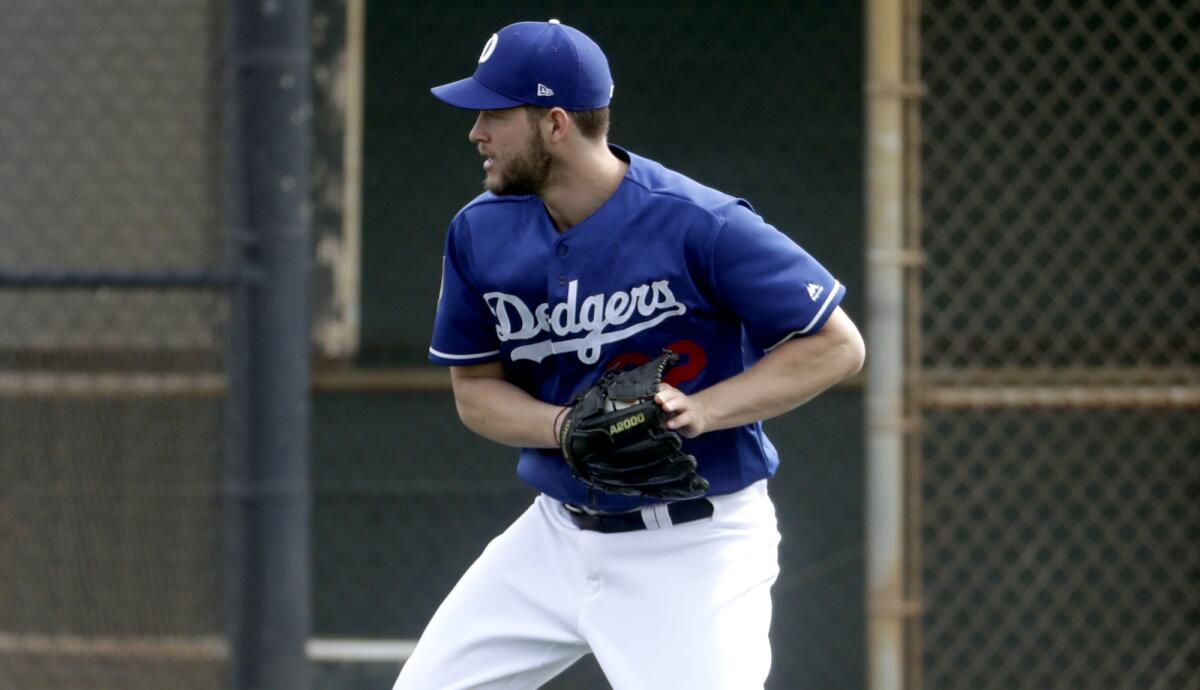Column: Clayton Kershaw’s aching shoulder is a touchy subject for Dodgers

- Share via
Reporting from phoenix — The major news at Dodgers camp pertains to a shoulder, only the story is about more than an irritated joint. The drama unfolding at Camelback Ranch is really about how a once-indestructible player is trying to resist the limitations forced on him by wear and tear.
If Clayton Kershaw is concerned about not throwing, he won’t show it. If he knows why he experienced discomfort last week, he won’t say why.
“I’m just taking a few days,” he said, adding he would resume playing catch Monday.
The response was as characteristic of Kershaw as his trademark curveball, the player who has always refused to show weakness again offering few details about something bothering him.
Whatever Kershaw says, the indisputable fact is that he has refrained from throwing a baseball over the last four days. Pitchers who shoulder heavy workloads are sometimes given breaks like this in spring training, but rarely so early in camp.
The previously unspecified “arm kind of thing” that has temporarily sidelined Kershaw was identified as shoulder inflammation by manager Dave Roberts on Sunday. Kershaw also experienced shoulder problems last year.
If he suffered serious damage, Kershaw would almost certainly have returned to Los Angeles for an examination. The Dodgers didn’t even consider it necessary for him to undergo an MRI examination and treated him with anti-inflammatory medication. Roberts reiterated that Kershaw is the team’s opening-day starter.
So, at this point, he figures to be able to pitch. The question is how he will pitch. The events of the last week raise legitimate concerns.
Kershaw will turn 31 next month. He is entering his 12th season as a major leaguer. Between the regular season and the playoffs, he has pitched 2,248 1/3 innings.
Sign up for our Dodgers newsletter »
Over the last couple of seasons, his fastball lost zip and his slider lost movement. He entered spring training with the publicly stated ambition to “regain some stuff that I lost.”
Roberts said Kershaw “didn’t feel right” throwing live batting practice or a subsequent bullpen session last week. Asked whether Kershaw was displeased with the velocity of his fastball or the movement of his slider, Roberts replied, “I think it was sort of all of the above.”
Was the discomfort in Kershaw’s shoulder caused by efforts to generate more fastball velocity?
“It might be,” Roberts said.
Kershaw dismissed the theory.
“You guys have all kind of put different angles for different things,” Kershaw said. “I’m just taking a few days now.”
Roberts discouraged Kershaw from concerning himself with velocity, with the manager saying the emphasis on speed was driven by Kershaw and not the organization.
“For us, he has so many different weapons that with his ability to command a baseball and sequence his weapons, he’s still an elite, elite pitcher,” Roberts said.
But as much as he has tried, Kershaw has failed to develop an effective changeup. His fastball and slider looked similar last season, when he was 9-5 with a 2.73 earned-run average in 26 starts.
In other words, it’s unlikely Kershaw can be Kershaw again by throwing fastballs in the low-90s as he did last season, not unless he radically changes his approach to pitching.
The Dodgers aren’t as dependent on Kershaw as they were in some previous seasons, in part because they have reached the World Series twice without him being superhuman and in part because Walker Buehler has emerged as a likely frontline pitcher. However, with a contract that guarantees him $93 million over the next three seasons, Kershaw remains the team’s highest-paid player.
The team’s signature pitching depth also isn’t what it used to be. Instead of stockpiling more arms in the offseason, the former free-spending Dodgers traded a valuable one in Alex Wood.
The rotation is expected to consist of Kershaw, Buehler, Rich Hill, Hyun-Jin Ryu and Kenta Maeda. Behind them is Ross Stripling, who faded after making the National League All-Star team last year. If the Dodgers have to turn to Stripling, they would be one injury from having to rely on Julio Urias, who barely pitched over the last two seasons because of a major shoulder injury. Kershaw’s presence remains important.
Roberts backed Kershaw, declaring multiple times that he will be an elite pitcher, regardless of how hard he throws.
“I think that that’s something that I know I believe and the organization believes,” Roberts said. “But the most important thing is that Clayton’s got to believe that because he’s still as good as there is.”
Because only then can Kershaw make the adjustments necessary. The Dodgers are invested in that.
Follow Dylan Hernandez on Twitter @dylanohernandez
More to Read
Are you a true-blue fan?
Get our Dodgers Dugout newsletter for insights, news and much more.
You may occasionally receive promotional content from the Los Angeles Times.










